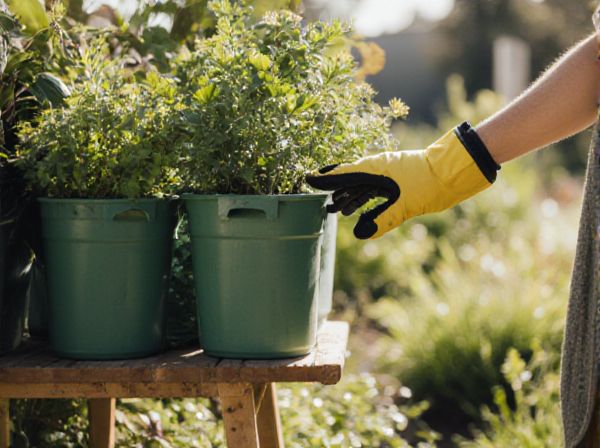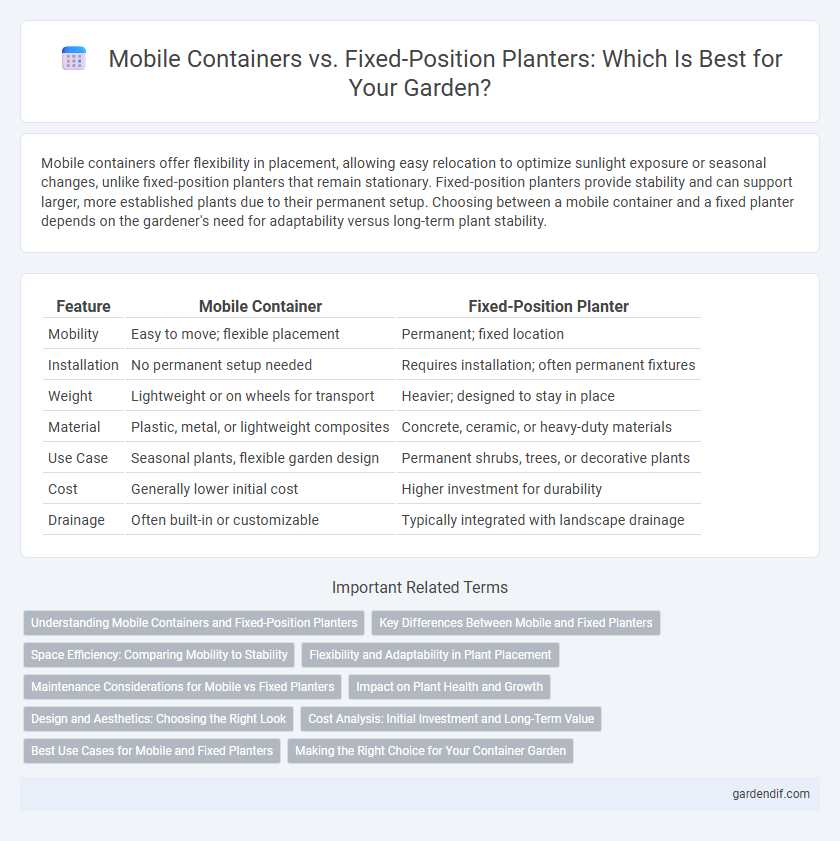
Mobile container vs fixed-position planter Illustration
Mobile containers offer flexibility in placement, allowing easy relocation to optimize sunlight exposure or seasonal changes, unlike fixed-position planters that remain stationary. Fixed-position planters provide stability and can support larger, more established plants due to their permanent setup. Choosing between a mobile container and a fixed planter depends on the gardener's need for adaptability versus long-term plant stability.
Table of Comparison
| Feature | Mobile Container | Fixed-Position Planter |
|---|---|---|
| Mobility | Easy to move; flexible placement | Permanent; fixed location |
| Installation | No permanent setup needed | Requires installation; often permanent fixtures |
| Weight | Lightweight or on wheels for transport | Heavier; designed to stay in place |
| Material | Plastic, metal, or lightweight composites | Concrete, ceramic, or heavy-duty materials |
| Use Case | Seasonal plants, flexible garden design | Permanent shrubs, trees, or decorative plants |
| Cost | Generally lower initial cost | Higher investment for durability |
| Drainage | Often built-in or customizable | Typically integrated with landscape drainage |
Understanding Mobile Containers and Fixed-Position Planters
Mobile containers offer versatility with lightweight materials and built-in wheels, allowing easy relocation for optimal sunlight and space management. Fixed-position planters provide stability and depth, supporting larger plants and long-term growth but lack the convenience of mobility. Choosing between mobile containers and fixed-position planters depends on available space, plant type, and the need for flexibility in garden design.
Key Differences Between Mobile and Fixed Planters
Mobile containers offer flexibility in garden design, allowing plants to be relocated easily to optimize sunlight exposure and seasonal changes. Fixed-position planters provide stability and are ideal for permanent landscaping features, supporting larger plants with extensive root systems. The choice depends on mobility needs, plant type, and space constraints, with mobile options enhancing versatility and fixed planters ensuring durability.
Space Efficiency: Comparing Mobility to Stability
Mobile containers offer superior space efficiency by enabling flexible rearrangement and easy relocation in constrained environments, maximizing usable area dynamically. Fixed-position planters provide stability and anchored functionality but limit spatial adaptability, often requiring more surrounding clearance. Choosing between mobile containers and fixed planters depends on prioritizing either mobility for versatile space management or the permanent presence of stable planting structures.
Flexibility and Adaptability in Plant Placement
Mobile containers offer superior flexibility by allowing plants to be easily relocated based on sunlight, weather, or aesthetic preferences, unlike fixed-position planters that remain static. This adaptability supports optimal growth conditions and enhances design versatility in gardens or indoor spaces. Gardens utilizing mobile containers can swiftly respond to environmental changes, ensuring healthier plants and dynamic layouts.
Maintenance Considerations for Mobile vs Fixed Planters
Mobile containers require regular inspection of wheels and casters to prevent rust and ensure smooth movement, while fixed-position planters demand less frequent mobility-related upkeep. Both types need consistent watering, soil replacement, and pest control; however, fixed planters often benefit from easier access to irrigation systems, reducing maintenance complexity. Seasonal adjustments for mobile containers include relocating to avoid harsh weather, whereas fixed planters may need enhanced drainage solutions to prevent waterlogging in one spot.
Impact on Plant Health and Growth
Mobile containers allow for easy relocation to optimize sunlight exposure, temperature, and protection from harsh weather, significantly enhancing plant health and growth. Fixed-position planters provide stable root environments but may limit adaptability to changing conditions, potentially stressing plants or reducing growth potential. Selecting a container type depends on the plant species' specific needs and the ability to control environmental factors effectively.
Design and Aesthetics: Choosing the Right Look
Mobile containers offer versatile design options with sleek wheels and compact frames, ideal for modern, dynamic spaces requiring flexibility and easy relocation. Fixed-position planters emphasize stability and often feature traditional, robust designs that enhance formal gardens or permanent landscaping with classic aesthetics. Selecting between them depends on the desired visual impact, spatial functionality, and complementing surrounding architecture.
Cost Analysis: Initial Investment and Long-Term Value
Mobile containers typically require a higher initial investment due to wheels and reinforced construction, while fixed-position planters generally cost less upfront with simpler designs. Over time, mobile containers offer greater long-term value through versatility and ease of relocation, reducing landscaping and maintenance costs. Fixed-position planters may incur additional expenses for site preparation and limited adaptability to changing garden layouts.
Best Use Cases for Mobile and Fixed Planters
Mobile containers offer flexibility for seasonal plant swaps, ideal for patios or balconies where sunlight changes throughout the day, enabling easy repositioning to optimize plant health. Fixed-position planters provide stability and are best suited for permanent garden beds or entryways, supporting larger plants and trees that require consistent root environments. Both types support diverse landscaping needs, with mobile units enhancing versatility and fixed planters providing long-term structural benefits.
Making the Right Choice for Your Container Garden
Choosing a mobile container over a fixed-position planter offers flexibility in optimizing sunlight exposure and protecting plants from harsh weather, ideal for urban gardeners or those with limited outdoor space. Mobile containers facilitate seasonal rearrangement and easier maintenance, enhancing plant health and aesthetic appeal. Fixed-position planters provide stability and larger growth capacity but may limit adaptability and require strategic initial placement to maximize garden productivity.
Mobile container vs fixed-position planter Infographic

 gardendif.com
gardendif.com